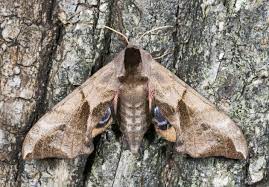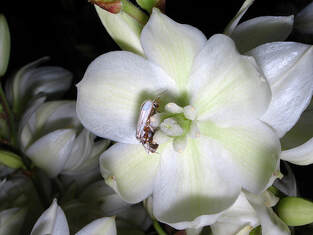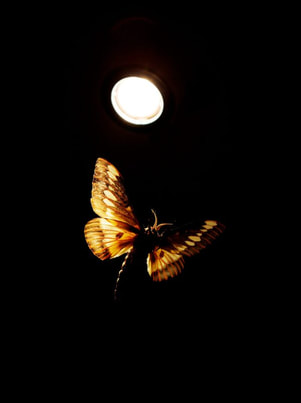
There is certainly less competition from other pollinators for the moths at night, which could increase their productivity as well. It seems scientists have discovered that moths not only visit the same range of plant species as the day shift does, but far more species of moth are involved in the effort, and they interact more often with certain flowers.
Dr. Callum MacGregor, who led a 2018 study as part of his Ph.D. research funded by the British Natural Environment Research Council (NERC) and Butterfly Conservation, said, “Over half of the plant species we detected were not previously known to be visited by moths. It was particularly interesting that moths were carrying pollen from many of the same plant species that are visited by bees, hoverflies, and butterflies.”
Scientists have known for a long time about certain moths that pollinate flowers. Most research has focused on the European Hawk Moth. It is known for its ability to fly long distances and its incredibly long proboscis, which can range from an average of 9 inches up to as long as 14 inches! Because the proboscis picks up pollen, the Hawk Moth can spread pollen as far away as eighteen miles. Hawk Moths don’t pollinate food crops. Consequently, there wasn’t as much research on them in the past as there was on insects that do.
In recent years, research has uncovered a lot more details about this night shift worker. We now know the moth is particularly drawn to pale-colored flowers with an open cup or a tubular-shape, which emit a strong fragrance at night. Honeysuckle is a favorite. Other such flowers are evening primrose, brunsfelsia, heliotrope, four-o’clock, and nicotiana (a nightshade).
 Yucca Moth on a Yucca plant.
Yucca Moth on a Yucca plant. Dr. Richard Walton (University College London, UCL), the lead author in a study published May 13, 2020, in the journal Biology Letters, said: “Nocturnal moths have an important but overlooked ecological role. They complement the work of daytime pollinators, helping to keep plant populations diverse and abundant. They also provide natural biodiversity backup, and without them many more plant species and animals, such as birds and bats that rely on them for food, would be at risk.”
As a backup to the food webs of daytime pollinators, moths could very well fill in that pollination gap if some daytime species die out, according to Walton. However, the severe declines in the moth population worldwide makes the decline of daytime pollinators even more serious.
Moths At Risk
A recent study in Britain has brought attention to dramatic declines in the larger moth populations over the last 50 years. Two common causes given for the decline of moths are agricultural intensification and light pollution in urban areas.
The industrialization of agriculture over the last seventy years has resulted in expanding areas for farming, growing the same crop year after year, and applying increasing amounts of pesticides and fertilizers. Additionally, the elimination of hedgerows and other wildlife habitat have been destructive to insect and other biodiversity in and near the fields. The resulting death toll includes pollinators, including moths, as well as predators of crop pests.
We’re all familiar with the sight of moths flying toward lights so it might not seem so weird to consider light pollution as a cause of moth deaths. However, a 2016 study also published in Biology Letters “tentatively suggests that moth behavior may adjust over time due to light pollution. On one hand, this means that they might not die at as high rates as expected given the threats posed by light pollution: decreased flight-to-light behavior means that moths might have a lowered chance of being attacked by predators or flying into light traps.” The other side of this is that their change in behavior may cause physiological changes, which could make it harder to pollinate as many plants or to adjust to habitat destruction.
Regardless, allowing light pollution to continue unabated could lead to changes in physiology that could make it harder for moths to pollinate plants widely or adjust to habitat destruction.
And Here at Home
The studies mentioned above were conducted in Britain, yet the same applies to moths here at home. No matter where they live though, these creatures excel in their nocturnal tasks by taking advantage of the reduced competition and their convenient hairy underbellies.
Another plus for the night shift: they transport pollen from vegetation never visited during the daylight hours. Namely, the plants that only open after dark.
As with the daytime crew, most moths are generalists and visit a variety of flowers for nectar and in return, spread the accumulated pollen far and wide. Also, as with other pollinator species, some moths co-evolved with and specialize in visiting only one plant. For instance, Yucca is totally dependent on… you guessed it, the Yucca moth, and visa versa. Female moths lay their eggs on the plant and rely on the Yucca seeds to feed their caterpillars.
Unfortunately, moths worldwide face the same predicaments stated above – habitat loss, exposure to toxic pesticides, disease, and light pollution. Another factor, air pollution also affects them. Vehicle and industrial emissions interfere with their scent-based navigation and communication.
So, please remember the hard-working moths working the night shift as you plan your pollinator habitat. Be sure to include night-blooming plants and turn off the porch light.
Interesting Facts About Moths
Houdini-like: Moths love camouflage. Some moths are known for their ability to impersonate other animals. To avoid being eaten, some moths have evolved to look like less palatable insects, such as wasps, and tarantulas as well as leaves. Some moths even mimic bird droppings.
Forced abstinence: The adult Luna moth doesn’t eat. It doesn’t even have a mouth. After it emerges from its cocoon, it lives for about a week. Its sole mission in life? To mate and lay eggs. Others without mouth parts include Polyphemus, Atlas, and Promethea.
Crazy for love: A male moth can smell a female many miles away. They detect odor molecules using their antennae instead of nostrils. Willing to fly upwind or down, the male doesn’t give up following the female’s seductive musk, even though he’s not the only suitor! Male giant silkworm moths have elaborate, feather-shaped antennae with hair-like scent receptors that allow them to detect a single molecule of a female moth's sex hormone from 7 miles away.

 RSS Feed
RSS Feed

